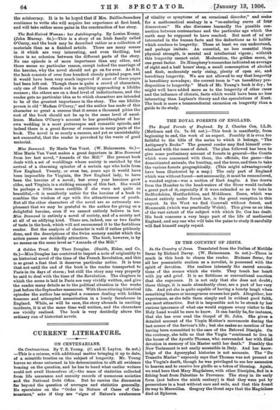C URRENT LITE RAT URE.
ON CENTENARIANS.
On Centenarians. By T. E. Young. (C. and E. Layton. 5s. net.) —This is a reissue, with additional matter bringing it up to date, of a scientific treatise on the subject of longevity. Mr. Young leaves no stone unturned in his determination to sift all evidence bearing on the question, and he has to hand what earlier writers could not avail themselves of;—the mass of statistics collected from life assurance and annuity records of numerous societies and the National Debt Office. But he carries the discussion far beyond the question of averages and statistics generally. He speculates on the " Order in Nature of Cases of Cen- tenarians," asks if they are "signs of Nature's exuberance
of vitality or symptoms of an occasional disorder," and seeks for a mathematical analogy in a "re-entering curve of four dimensions." He also discusses learnedly the possible con- nection between centenarians and the particular age which the earth may be supposed to have reached. But most of us are interested in the human facts and the deductions as to habits which conduce to longevity. These at least we can understand, and perhaps imitate. An essential, no less essential than physical strength, is mental and intellectual vigour ; withbizt this longevity cannot exist. Moderation, the golden mean, is one great factor. Dr. Htimphrey's researches indicated an average of eight and a half hours' sleep, a small consumption of alcohol and flesh, moderately early rising," plenty of open air, and hereditary longevity. We are not allowed to say that longevity is hereditary nowadays; the correct term is "an hereditary pre- disposition to longevity." Much of Mr. Young's book is dry ; he might well have added more as to the longevity of other races and the influence of climate, facts which would have been no less interesting than Laplace's theory and the speculations of Kant. The book is more a transcendental excursion on longevity than a guide to its study.










































 Previous page
Previous page